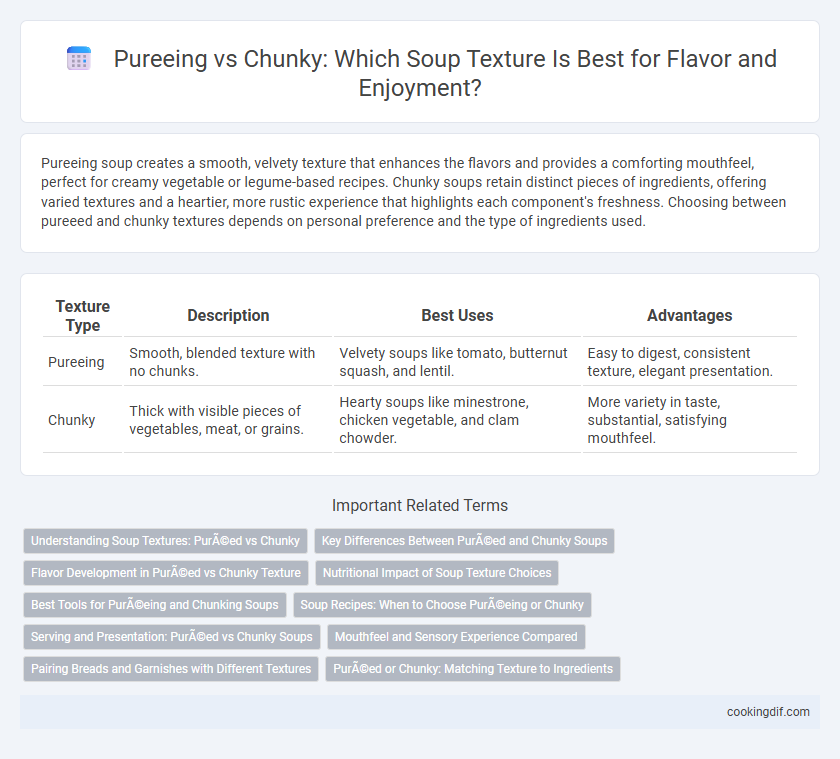Pureeing soup creates a smooth, velvety texture that enhances the flavors and provides a comforting mouthfeel, perfect for creamy vegetable or legume-based recipes. Chunky soups retain distinct pieces of ingredients, offering varied textures and a heartier, more rustic experience that highlights each component's freshness. Choosing between pureeed and chunky textures depends on personal preference and the type of ingredients used.
Table of Comparison
| Texture Type | Description | Best Uses | Advantages |
|---|---|---|---|
| Pureeing | Smooth, blended texture with no chunks. | Velvety soups like tomato, butternut squash, and lentil. | Easy to digest, consistent texture, elegant presentation. |
| Chunky | Thick with visible pieces of vegetables, meat, or grains. | Hearty soups like minestrone, chicken vegetable, and clam chowder. | More variety in taste, substantial, satisfying mouthfeel. |
Understanding Soup Textures: Puréed vs Chunky
Pureeing soup creates a smooth, velvety texture by blending ingredients until fully emulsified, enhancing flavors with a consistent mouthfeel ideal for creamy varieties like butternut squash or tomato bisque. Chunky soups retain larger pieces of vegetables, meat, or legumes, providing a hearty, rustic experience that highlights individual ingredients and adds bite and varied texture. Choosing between pureed and chunky depends on desired sensory appeal and the soup's cooking method, with pureed soups often relying on immersion blenders or food processors, while chunky soups benefit from slow simmering to tenderize solids without losing structure.
Key Differences Between Puréed and Chunky Soups
Pureeed soups offer a smooth, creamy texture achieved by blending ingredients into a uniform consistency, enhancing flavor integration and ease of digestion. Chunky soups contain distinct pieces of vegetables, meat, or legumes, providing varied texture and a hearty, rustic eating experience. The key difference lies in texture and mouthfeel, with pureed soups emphasizing smoothness and chunkier varieties highlighting ingredient individuality.
Flavor Development in Puréed vs Chunky Texture
Pureed soups offer enhanced flavor development as blending breaks down ingredients, releasing their essential oils and intensifying aromatic compounds. Chunky soups retain distinct flavors from individual components, creating a contrast that highlights texture but may dilute the overall depth of taste. The smooth consistency of pureed soups allows for a more uniform flavor profile, making each spoonful rich and cohesive.
Nutritional Impact of Soup Texture Choices
Choosing pureed soups enhances nutrient absorption by breaking down fiber and cell walls, making vitamins and minerals more bioavailable. Chunky soups preserve more intact fiber, which supports digestive health and provides a slower glucose release. Both textures impact satiety differently, with chunky soups promoting longer fullness due to higher fiber content and pureed versions offering quick nutrient availability.
Best Tools for Puréeing and Chunking Soups
Blending soups to a smooth puree is best achieved using immersion blenders or high-powered countertop blenders, which ensure even texture without overprocessing. For chunkier soups, a sturdy wooden spoon or a slotted spoon helps maintain distinct vegetable and meat pieces. Using the right tool enhances the soup's desired texture and preserves flavor integrity.
Soup Recipes: When to Choose Puréeing or Chunky
Pureeing soup creates a smooth, creamy texture ideal for recipes featuring vegetables like butternut squash or tomatoes, enhancing flavor integration and making digestion easier. Chunky soups retain distinct pieces of ingredients such as vegetables, meat, or legumes, offering varied textures and hearty satisfaction, perfect for minestrone or chicken vegetable soup. Choosing between pureeing or chunky relies on desired mouthfeel, ingredient type, and culinary tradition of the soup recipe.
Serving and Presentation: Puréed vs Chunky Soups
Pureed soups offer a smooth, velvety texture that enhances elegant serving and presentation, often garnished with herbs or a swirl of cream for a refined look. Chunky soups provide a hearty, rustic appeal, showcasing visible ingredients like vegetables, meats, and grains that add visual interest and texture variety on the plate. Choosing between pureed and chunky soups depends on the desired dining experience, with pureed soups fitting formal settings and chunky soups suited for casual, comforting meals.
Mouthfeel and Sensory Experience Compared
Pureeed soups offer a smooth, velvety mouthfeel that intensifies flavor perception by evenly distributing ingredients and creating a cohesive sensory experience. Chunky soups provide varied textures with distinguishable pieces of vegetables or meat, enhancing chewiness and adding complexity to each bite. Sensory experience differs significantly as pureeed textures promote comfort and warmth, while chunky soups stimulate interest and satisfaction through textural contrast.
Pairing Breads and Garnishes with Different Textures
Pureeed soups feature a smooth, velvety texture that pairs exceptionally well with crusty artisan breads or crunchy croutons, enhancing contrast while complementing the creamy base. Chunky soups, with their hearty, textured ingredients, benefit from softer bread options like warm sourdough or brioche that soak up flavorful broths without overwhelming each bite. Garnishes such as fresh herbs, toasted nuts, or dollops of cream add nuanced textures and layers of flavor, making each spoonful a balanced sensory experience.
Puréed or Chunky: Matching Texture to Ingredients
Pureeed soups highlight the smooth, creamy texture of ingredients like cooked vegetables or legumes, enhancing their natural flavors and creating a velvety mouthfeel. Chunky soups preserve the distinct shapes and textures of hearty ingredients such as diced tomatoes, potatoes, or beans, offering a more robust and varied eating experience. Choosing between pureed or chunky textures depends on the desired balance between smoothness and ingredient integrity to complement the soup's flavor profile.
Puréeing vs Chunky for texture Infographic

 cookingdif.com
cookingdif.com